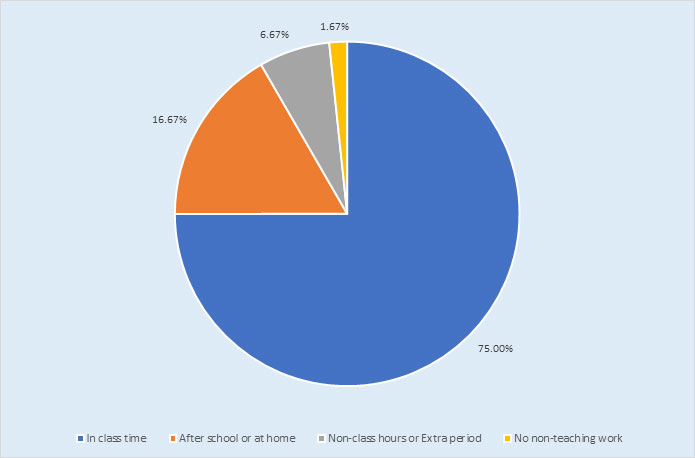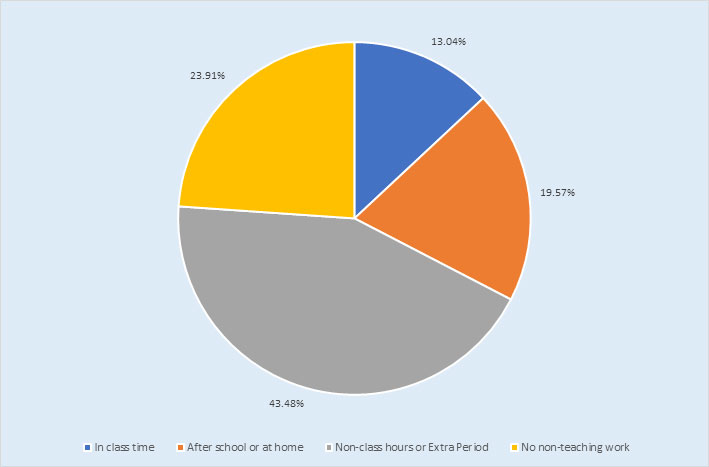While the Right to Education Act, 2009 mandates 200 days of teaching for primary classes, the actual number seems to be much lower in government schools. Based on qualitative fieldwork and a survey in Udaipur district of Rajasthan, Indira Patil discusses why government-school teachers prioritise non-teaching work over classroom engagement, and how this impacts school choices of parents.
The Right to Education Act, 2009 (RTE) mandates 200 days of teaching for primary classes. However, the actual number of days of teaching for primary classes in government schools seems to be much lower than that prescribed by the RTE. One of the major reasons for low classroom teaching is the high non-teaching work burden that keeps teachers outside the classroom during teaching hours.
Based on qualitative fieldwork, and a quantitative survey of over 100 teachers and principals across 40 government and low-fee private (LFP) schools in Udaipur district of the state of Rajasthan – conducted as part of a research study called Researching Accountability in the Indian System of Education (RAISE) – I discuss why teachers prioritise non-teaching work, and how this affects classroom engagement (or teaching) time and in turn, school choices of parents.
Reduced classroom engagement time
Classroom engagement time can be understood as the time spent by teachers on teaching and engaging with students in the classroom. Two aspects determine the classroom engagement time – the number of working days of the school, and number of hours spent by the teacher in the classroom on each working day.
The annual academic calendar of 2019-20, published by the Department of Education of the state government of Rajasthan, prescribes 206 working days for schools other than celebration days. During the academic year from May 2019 to April 2020, two elections – the general elections at the national level and panchayat elections at the village level – were held in Rajasthan. Government-school teachers were appointed as booth-level officers and were given training for election duty. Also, schools served as voting booths and were closed for a few days for security and setting up purposes. Thus, schools were not functional for a total of about 10 days during each of these elections. Combined with the week of exams, there were less than 200 working days for teaching and classroom engagement.
Further, the annual academic calendar mandates daily teaching of 4 hours during April-September (summer schedule) and 5 hours during October-March (winter schedule). It prescribes the following timetable for schools during the winter schedule:
Table 1. Winter timetable as prescribed by the annual academic calendar (Department of Education, Rajasthan)
|
Assembly |
10 AM – 10:25 AM |
|
Classes |
10:25 AM – 1:05 PM |
|
Midday meal |
1:05 PM – 1:30 PM |
|
Classes |
1:30 PM – 4 PM |
However, the actual time spent teaching seems to be much lower. Below are excerpts from classroom observations of grade 5 in a government school in Chikpur1 village:
Day 1: Teachers arrive in school at 10:15 AM. Students keep arriving until 10:30 AM, even after the start of the assembly. The assembly begins at 10:20 AM and goes on till 10:50 AM. After the assembly, students of grades 1 to 5 are asked to sit together and watch ‘TV’ (the smart board, which is an interactive digital board, is referred to as ‘TV’)2 The teacher says he has to document the textbook requirement for the next academic year and today is the last day for sending it.
The students are cramped inside the classroom, with a few of them changing lessons on the smart board, others playing and running around, and few others reading and writing. The classroom is chaotic. At 11:20 AM, a grade 6 boy asks students to come and drink milk. The students run out of the classroom immediately, and return at 11:50 AM. A few students are playing outside. After some time, the teacher enters the class and asks students to maintain silence. He informs them that no teaching will take place today as he would be going to the block office to submit some documents. By this point, many students are playing outside, with only a few watching the smart board, while others are reading, writing or playing indoors. The school has a lunch break between 1 PM and 2 PM. Student attendance has now reduced and the students who are present are mostly playing and running around. The students leave at 3:30 PM while the teachers leave at 3:50 PM.
Day 2: The scenario is slightly different from the previous day. The teacher is documenting the height and weight of students in primary classes during the pre-lunch session. A few students of grades 1 to 5 are seen playing in the corridor while others are watching the smart board. After lunch, the teacher engages with the class for an hour from 2 PM to 3 PM and thereafter asks students to play sports.
When discussing a typical day at a government school in Chikpur, a teacher said “School starts at 10 AM. Till 11:30 AM, we have the assembly prayers, cleaning, and milk provisioning. We then have classes till 1 PM, along with supervising the preparation of the midday meal. Meanwhile, if we receive any WhatsApp messages from officials of the Education Department such as the Block Education Officer, District Education Officer, etc., with tasks for us, then we complete the assigned work (such as providing data regarding school management, or fund utilisation, midday meal expenditure) and send it across. Then, from 1 PM to 1:30 PM we have the midday meal, which often ends by 2 PM, and class then goes on till 3 PM. After 3 PM, we mostly leave students to play as they do not feel like sitting in the classroom.”
On both days, teachers were involved in documentation work during classroom hours and spent very little time in the classroom. Similar observations were recorded in other government schools across Udaipur during both qualitative and quantitative phases of the study.
Table 2. A typical day in government school in Chikpur
|
Assembly |
10:15 AM – 10:45 AM |
|
Cleaning classrooms |
10:45 AM – 11 AM |
|
Milk served |
11 AM – 11:30 AM |
|
Classes |
11:30 AM – 1 PM |
|
Midday meal |
1 PM – 2 PM |
|
Classes |
2 PM – 3:15 PM |
|
Sports |
3:15 PM – 3:45 PM |
Classroom teaching takes place for about 2.5-3 hours a day, that is, around 50-60% of the prescribed time. Thus, total classroom engagement time is much lower than that mandated by the RTE. As observed, non-teaching work burden is one of the main reasons for low classroom engagement. It is possible that teachers have a tendency to cite non-teaching work as an excuse for not engaging with students in the classroom, during the hours prescribed for this purpose. However, the extent of non-teaching work burden cannot be ignored.
Why teachers prioritise non-teaching work
When talking to a government-school teacher from Dholpur village, he said “When officials visit the school, they check whether milk has been served and whether the midday meal has been prepared and served at the school. The emphasis is not on whether Math or Hindi class took place on the day. Every day we spend 2-3 hours ensuring that milk and food are served. One day there is no cylinder, another day there are no groceries, another day there is no milk. One way or another, we have to ensure that milk and food are served. This inevitably becomes our priority over taking classes”.
During this conversation, he received a forwarded message on WhatsApp from the Panchayat Elementary Education Officer seeking data on the number of teachers appointed and teacher vacancies at the school.
When asked about the frequency of administrative orders and circulars that are received via WhatsApp messages, a government-school principal in Sanpur village said, “We receive a circular every alternate day. The data are available online, but officials find it convenient to send WhatsApp messages to principals (or teachers) to get the data. For instance, last week, a question was asked during the Legislative Assembly session on the number of teacher vacancies. This information is available online, yet we received a message from the higher officials to send the list of the number of teacher appointments and vacancies in all government schools of the panchayat”.
Thus, there seems to be duplication of work, as teachers often engage in compiling and sending data that have already been documented and are available online or with the officials.
As a government-school teacher from Sanpur village notes, “the common perception is that government-school teachers are complacent and do not work. We work, but we work more like clerks and less like teachers – we keep filling documents and upload data and hence, do not get enough time to teach properly. If you log on to the ‘Shala Darpan’3 website at night, you will find thousands of teachers online, filling in data. We undertake paper documentation at school and online documentation at home. There is no working computer at the school or high-speed internet available in the village''.
The ad-hoc distribution of administrative work and the vigilant wait for WhatsApp messages with orders/circulars, is often arduous. According to a government-school principal from Chikpur village, “The moment my phone rings, I think of the WhatsApp message and what it might be about – training, an event, or a data requirement. It is like a sword hanging on our heads”. Thus, teachers are held accountable for the completion of non-teaching work rather than classroom engagement time.
Government schools in Udaipur, particularly in rural areas, mainly cater to students from tribal communities, who are mostly first-generation learners. The limited presence and engagement of teachers in the classroom because of non-teaching work delays the completion of lessons and adversely affects the learning of students. This further exacerbates the existing learning gap of students from disadvantaged communities.
Non-teaching work of government vis-à-vis private school teachers
Figure 1 shows that around 75% of government teachers said they are involved in non-teaching activities during class time. On the other hand, Figure 2 shows that only 13% of teachers in LFP schools said they were involved in non-teaching work4 during class time. While 43.5% of private-school teachers said they engage in non-teaching work during non-class hours or extra classes, 23.9% said they have no non-teaching responsibilities.
Figure 1. When are non-teaching activities undertaken by government-school teachers?
Figure 2. When are non-teaching activities undertaken by low-fee private-school teachers?
Further, 83% of the surveyed government-school principals said that they do non-teaching work during class time. On the other hand, only 6% of private school principals said that they engage in non-teaching work during class time, while 94% of them said that they have distributed the work to teachers who do it during non-class hours or free sessions.
Government-school teachers tend to be better qualified than most teachers in LFP schools. Of the 46 LFP-school teachers surveyed in Udaipur, nearly a quarter of them did not have a teaching degree. In contrast, all of the 60 government-school teachers surveyed had a teaching degree. While all government-school teachers received annual in-service training, LFP school teachers did not receive any kind of in-service training. However, non-teaching work burden results in lower time being spent in classrooms by teachers in government schools than the teachers in private schools.
How classroom engagement drives school choice
It is seen that classroom engagement time is one of the major driving factors for parents to send their children to private schools. Sarita, mother of a grade five student of a Chikpur government school, shared that she was aware of the low classroom engagement at the school and said “no teaching happens in lower classes. Teachers switch on the ‘TV’ and ask students to watch it. They are busy with paperwork (kagaz likhte rehte hain).”
Further, Manisha from Chikpur village who sends her children to a LFP school in neighbouring Lalpur village, said “in private schools, the teacher pays attention to students (dhyaan dete hain), is present in the class (class mein rehte hain) and students are in the school (bachhe school mein rehte hain)”. Thus, greater engagement and not ‘quality’ of engagement is driving the school choice of families towards LFP schools.
Way forward: Prioritising classroom engagement
The newly drafted National Education Policy acknowledges non-teaching duties as one of the biggest challenges for teachers and says that “aside from the minimal Supreme Court directives related to election duty and conducting surveys, teachers will not be requested nor allowed to participate in any non-teaching activities during school hours that affect their capacities as teachers.”
The non-teaching work largely involves school management, data collection, and documentation, with duplication and redundancy in many instances. The intermittent distribution of non-teaching work through the day and the pressure to be ready to act on the calls of higher authorities often burden the teachers and affect their ability to devote time to the primary role of teaching.
It is important that policymakers and bureaucrats at the higher echelons consider how duplication and redundancy may be reduced in processes, while allotting or directing non-teaching work to teachers. Also, there is a need to recruit a greater number of non-teaching staff in schools for undertaking administrative work. In cases, where documentation is online, offline documentation must be eliminated. In rural schools, where there is no/limited internet connectivity and IT resources, these must be provided, and offline documentation may be allowed. Where data are already available, schools must not be asked to compile and send it. Moreover, teachers must be primarily held accountable for their classroom engagement over other non-teaching activities.
Notes:
- All names of localities and individuals have been anonymised to protect identities.
- The students (including parents) refer to the smart board as ‘TV’, indicative of its perception as a means of entertainment through sound and visual effects to engage students. The lessons are in English and Hindi – many words/phrases are incomprehensible by students, as these are not used locally (where they speak Mewari, the local language). The teachers have not received any training on using the smart board, and do not facilitate understanding of the context of the lessons among the students. Instead, the smart board is used as a substitute to teachers, when they are not present in the classroom and are involved in non-teaching work.
- ‘Shala Darpan’ bis an online portal managed by the state government of Rajasthan which serves as a database of information regarding government schools and education offices.
- The non-teaching activities in LFP schools, as per the teachers, largely involve cultural and extracurricular activities. Some teachers also mentioned notebook-checking, exam paper correction, and maintaining student attendance registers as non-teaching activities. On the other hand, in government schools, non-teaching activities mostly include work related to school management/administration, data documentation as directed by higher authorities, and various government schemes like midday meal, milk provisioning, or distribution of iron tablets
I4I is now on Telegram. Please click here (@Ideas4India) to subscribe to our channel for quick updates on our content.




 22 October, 2020
22 October, 2020 






By: Shivani Rao 22 October, 2020
Very well articulated. We get to see and understand the real reason so as to why parents of the lower economic belt are adamant on enrolling their kids in a private school.